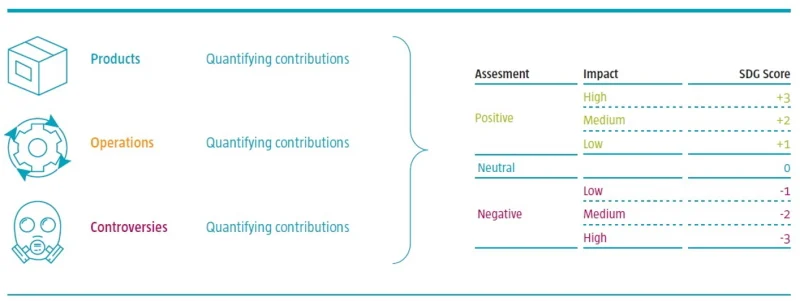What began as a novel and previously untried method to assess the contributions that companies make to the UN’s Sustainable Development Goals now forms a basis for defining sustainable investing across the whole company. It has come a long way, and we are very proud of how our seedling has blossomed.
The Framework uses a three-step method to quantify corporate contributions – both good and bad – to the 17 goals. The SDGs range from eradicating hunger and inequality to tackling climate change and promoting sustainable industry. They are being used as a blueprint for investors who want to shift capital towards companies providing solutions for society’s problems and away from those that have negative environmental and social impacts.
Investors need good data for that. So, our analysts examine what a company does, how it does it, and whether it has been involved in any controversies. Once the data is known, a scoring system is used that ranges from -3 (a highly negative contribution) through zero (neutral) to +3 (highly positive), as seen in the illustration below.

The Framework was originally designed in 2017 to find candidates for two SDG credits and equities strategies launched in 2018. Companies with positive scores could be considered for inclusion, and those with negative scores rejected. Beginning with just a handful of companies, in recent years the Framework has massively expanded its range.
We used academic research on the linkages between sectors and SDGs; applied natural language processing (NLP) techniques to read companies’ business descriptions; and then fed in data from numerous sources. Combined, this allowed us to assign SDG scores to more than 15,000 companies – leading us to have near universal coverage of our universe.
Its usefulness for stock selection is immense. We know not only know how positive or negative a company is for the SDGs overall; we can also show which SDGs are impacted by a company. For example, the Framework found that around 30% of the companies in the MSCI All Country World Index contribute to SDG 8 (Decent work and economic growth) and SDG 9 (Industry, innovation and infrastructure). Another 16% contribute positively to SDG 3 (Good health and well-being). Negative impacts are most often associated with climate change, with 11% of MSCI ACWI companies negatively impacting SDG 13 (climate action).
企業和國家/經濟體在可持續發展的表現評分為何?
查看企業對聯合國可持續發展目標(SDG)所作出的貢獻作出評分,也對國家/經濟體在環境、社會和管治(ESG)準則的表現進行排行。
Used across the company
The Framework proved so adept at assessing companies’ impacts on sustainable development that we can now provide a diverse range of SDG investment strategies. These cross different asset classes – equity and fixed income – as well as the investment styles of fundamental, quant and indices. It will be further used by the multi-asset team to underpin sustainability across asset classes.
Using the SDGs as a scoring mechanism forms part of a wider belief that SI is moving on from a sole focus on ESG integration. Whereas ESG typically looks at how a company’s financial performance is affected by environmental, social or governance factors, the SDG score assesses if an investment is actually making a positive impact on the ground.
This is an important difference: various tobacco companies can get top-notch ESG ratings while they have negative SDG scores due to their adverse health impacts. This impact philosophy lies at the core of the SDGs themselves.
A defining moment
A further development is the role that SDG scores will play in meeting the reporting and disclosure requirements of the EU’s Sustainable Finance Disclosure Regulation (SFDR). Under the SFDR Level 2 Regulatory Technical Standards, from 2023 the Framework will be used as one way to define what is actually considered a sustainable investment at Robeco. If a company scores positively, then it can be labelled as sustainable. This system will also determine whether a strategy can be labeled as ‘Article 9’ pursuing a wholly sustainable objective.
Next to regulation, the SDG scores form part of product innovation. The fact that some companies are trying to become more sustainable but are not quite there yet – getting low negative -1 or zero scores on the Framework – led to the creation of an entirely new strategy. Companies that were willing to engage with Robeco’s Active Ownership team to improve their scores are included in the SDG Engagement Equities strategy that is already seeing results.
And as a strong believer in sharing our knowledge for the furtherment of sustainable investing, Robeco is now sharing the intellectual property of the Framework with stakeholders including clients and academics. This is the first step in the SI Open Access Initiative which began in August 2022.
Our updated brochure
So, as the SDGs reach the half-way stage in their 2015-2030 targets, we can be proud of how far the Framework has come in helping to achieve these goals. The goals are a marathon, not a sprint, but we’ve laid the groundwork for finishing the race by developing a world-leading analysis tool.
How it all works is explained in an update to our SDG Framework brochure, including some examples of how it applies to individual SDGs, and how the scores are used in portfolio construction.
Download the brochure here免責聲明
本文由荷宝海外投资基金管理(上海)有限公司(“荷宝上海”)编制, 本文内容仅供参考, 并不构成荷宝上海对任何人的购买或出售任何产品的建议、专业意见、要约、招揽或邀请。本文不应被视为对购买或出售任何投资产品的推荐或采用任何投资策略的建议。本文中的任何内容不得被视为有关法律、税务或投资方面的咨询, 也不表示任何投资或策略适合您的个人情况, 或以其他方式构成对您个人的推荐。 本文中所包含的信息和/或分析系根据荷宝上海所认为的可信渠道而获得的信息准备而成。荷宝上海不就其准确性、正确性、实用性或完整性作出任何陈述, 也不对因使用本文中的信息和/或分析而造成的损失承担任何责任。荷宝上海或其他任何关联机构及其董事、高级管理人员、员工均不对任何人因其依据本文所含信息而造成的任何直接或间接的损失或损害或任何其他后果承担责任或义务。 本文包含一些有关于未来业务、目标、管理纪律或其他方面的前瞻性陈述与预测, 这些陈述含有假设、风险和不确定性, 且是建立在截止到本文编写之日已有的信息之上。基于此, 我们不能保证这些前瞻性情况都会发生, 实际情况可能会与本文中的陈述具有一定的差别。我们不能保证本文中的统计信息在任何特定条件下都是准确、适当和完整的, 亦不能保证这些统计信息以及据以得出这些信息的假设能够反映荷宝上海可能遇到的市场条件或未来表现。本文中的信息是基于当前的市场情况, 这很有可能因随后的市场事件或其他原因而发生变化, 本文内容可能因此未反映最新情况,荷宝上海不负责更新本文, 或对本文中不准确或遗漏之信息进行纠正。


